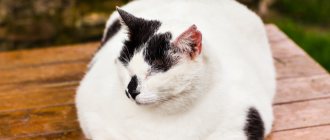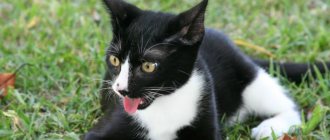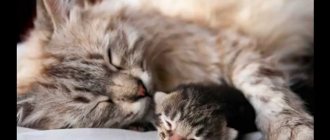When you don't need to worry
Normally, a cat breathes through its nose and does not stick out its tongue. However, in some cases, you can notice the opposite in an animal that does not have any health problems. For example, if :
- the pet is frightened by something, excited, furious (in general, is in a stressful state);
- the cat has not yet recovered from active games, for which it expended a huge amount of energy;
- the female is about to give birth;
- the cat is hot.
In the first three situations, the cat can hardly be helped in any way. You can be sure that breathing will soon return to normal on its own. If the pet is hot and he breathes heavily with his mouth open, evaporating moisture from the tongue, which helps to lower the body temperature, you need to take him out of the stuffy room or, conversely, bring him into the house from the hot street. Cats, like people, can get heatstroke due to extreme overheating. It’s better not to let things get to this point, as the consequences can be unpredictable.
Pathological causes
It happens that owners observe breathing problems in their cat for quite a long time. However, the factors from the above list are absent. Why, in this case, can the cat breathe heavily, often, sticking out its tongue? Here are the most common dysfunctions in which this symptom appears :
- a foreign body that has entered the respiratory tract and blocked the air supply;
- painful lesions of the oral mucosa (mechanical damage, ulcers, rashes, fistulas, inflammation);
- ARVI and similar ailments, in which mucus accumulates in the nose and other parts of the respiratory tract (oxygen is not easy to reach its destination, and the cat breathes with its tongue sticking out to get more air);
- lung pathologies (inflammation, edema, tumor, pulmonary failure);
- cardiovascular diseases (angina pectoris, coronary artery disease, hypotension, hypertension);
- injuries to the ribs and muscles in the area of the lungs, as a result of which the latter are compressed, their volume decreases, the body does not have enough oxygen, so the cat breathes with its tongue hanging out;
- dysfunction of the brain, namely the part of it that is responsible for breathing;
- poisoning, in which the general condition of the body leaves much to be desired, and malfunctions in the functioning of almost all systems are observed.
This is new material, but Tiger Cub once wrote on this topic - “Adenoids”.
(Please note that the information contained in an earlier article may not be entirely current.) Now we invite you to familiarize yourself with the modern view of this problem.The article was prepared by otorhinolaryngologist of the Tiger Cub Children's Clinic Ramazanova Gunay Alniyazovna
ENT doctors are sounding the alarm: every 2nd child has problems with adenoids. If you look closely at children in older kindergarten groups and first-graders, you can easily notice those suffering from adenoids - such children breathe through their mouths. It would seem that there is nothing wrong. But, if you do not intervene and let everything take its course, then adenoids can cause not only constant colds, but also such serious complications as purulent otitis media and hearing loss. Until recently, the only method to solve the problem was surgery. Today, doctors have found a way to do without surgery.
What are adenoids and why do they become a problem?
Adenoids are located behind the nose, in the nasopharynx. In childhood, adenoid and lymphoid tissue protects us from infections. Normally, by the age of 14, the adenoids, having fulfilled their function, disappear by themselves. This occurs under the influence of sex hormones. It is extremely rare that adenoids persist in adults.
Adenoiditis most often “blooms” in children aged 5 to 7 years. It is during this “transitional age,” when a child becomes a schoolchild, that the number of lymphocytes in the blood decreases, which leads to a decrease in the body’s resistance to infections and viruses. This period is physiological. To protect the body, the adenoids increase in size. Unfortunately, in many children this causes the adenoids to block the nasopharynx and make breathing difficult.
Lymphoid tissue can also become a focus of infection. Viruses and bacteria enter the nasopharynx through the nose and onto the adenoid tissue. The adenoids begin to fight the infection. If the fight is unequal, then the adenoids become inflamed. And in this case, the adenoids themselves become a source of infection. Due to the fact that the auditory tubes are located next to the adenoids, festering adenoids can provoke otitis media. This scenario is one of the most dangerous. Purulent otitis, exudative otitis can lead to hearing loss for life.
Frequent colds and infectious diseases are just the tip of the iceberg. Constant, so-called “habitual” mouth breathing leads to a number of disorders of the internal organs. Habitual mouth breathing is characterized by non-closure of the lips, changes in the position of the tongue, which affects the position of the dentition and bite. Which in turn can lead to the development of serious problems of the entire musculoskeletal system (hence problems with posture) and will have a negative impact on all organs and systems of the body.
How to break this vicious circle?
Nasal breathing is very important for a child. A growing body needs oxygen more than adults. If you teach your child to breathe through his nose again, then all of the above problems can be avoided. But how to do that? After all, the child begins to breathe through his mouth forcibly.
Due to the fact that the adenoids cover the invisible part of the nostrils at the back, the so-called “choanae,” the child cannot breathe through his nose. Even if he inhales through his nose, the adenoids block the exit to the nasopharynx, blocking the air. Therefore, children begin to breathe through their mouths. In frequently ill children, the nasal mucosa and the adenoids themselves swell, which makes breathing even more difficult. A common picture: a child goes to kindergarten or school and encounters infections there. What happens in the body? The adenoids enlarge compensatoryly, blocking the choanae, and the child begins to breathe through the mouth. It turns out to be a vicious circle - mouth breathing leads to frequent infections, and in response to infections the adenoids enlarge. The problem is that until the child learns to breathe through his nose, the adenoids will not shrink. Such children need to be weaned from mouth breathing. It's not easy, but it's possible. Newborn babies can only breathe through their nose - this is vital during the sucking process.
Mouth breathing is a bad habit! A healthy person should breathe only through the nose. When breathing through the mouth, the amount of oxygen entering the human body is only 78% of the normal volume, and with chronic mouth breathing, hyperventilation of the lungs develops. A mouth-breathing child inhales every 3 seconds. For this reason, 10 times more pathogens enter the body through the nasal passages.
If the child breathes through the mouth, treatment is necessary. But first you need to determine the cause of mouth breathing.
When is surgery needed?
If endoscopy of the nasopharynx has not been performed, tympanometry and the doctor during a routine examination says: an adenotomy is needed - this is the wrong approach. In the 21st century, you need to do a full examination. If the child is restless and it is impossible to perform an endoscopy, then at least a CT scan or x-ray of the nasopharynx should be done. Without an endoscopy or x-ray, a doctor cannot adequately assess what exactly is causing the problem. Brain hernia? Tumor? Or is it still adenoids? Endoscopy of the nasopharynx eliminates such questions.
Alarming symptoms: ✓ The child does not breathe through his nose. The mouth is almost always slightly open. ✓ Frequent diseases: acute respiratory infections, flu, colds, bronchitis, tonsillitis, laryngitis, sore throat. ✓ Exudative otitis media - frequent otitis, especially purulent ones, can be a consequence of problems with the adenoids. ✓ Apnea syndrome (snoring with pauses in breathing during sleep), when the child seems to “freeze” for several moments.
Apnea syndrome in children is very dangerous. If there are frequent purulent otitis media and there is “freezing” in sleep, you still need to remove the adenoids surgically. If there are no pauses in breathing during sleep, then the child can and should be treated conservatively.
✓ Malocclusion and crowded dentition. ✓ Problems with diction.
If there is at least one of the signs, then you should contact a specialist. And best of all - to several. An interdisciplinary approach, when doctors from different specialties work together to solve one problem, is optimal in this case. A child with mouth breathing should definitely be examined not only by an ENT specialist, but also by an orthodontist. Very often the help of a speech therapist is required.
Treatment of adenoids without surgery: how does it work?
You need to pay attention to the shape of the jaws. The upper jaw and hard palate are the anatomical floor of the nose. If the jaws narrow, the volume of the nose decreases and the person cannot breathe fully. After the examination, the doctor selects special removable devices made of medical silicone for the child - myofunctional orthodontic trainers. On the upper and lower jaw. During the entire treatment period (up to six months), the child must sleep with the trainers and wear them during the day for 1 hour, every day. In addition, breathing exercises and exercises for the perioral muscles and tongue are prescribed. The trainer gradually, very gently, acts on the jaws and forces them to take a physiologically correct position, stimulating their growth and development. The air flow through the nasal passages improves - air circulates freely during inhalation and exhalation. In the process of such treatment, the upper respiratory tract is formed correctly, the lumen of the upper respiratory tract in the area of the pharyngeal tonsil increases. Children stop snoring and begin to breathe normally through their nose.
Wearing trainers in combination with breathing and muscle exercises teaches the child to close his lips at rest, since the tone of the orbicularis facial muscle and the lip-closure reflex are stimulated. The child gets used to the trainer within 10-14 days. The exercises take 5-10 minutes and are easy to remember and perform. The first results become visible after 3-6 months. This is expressed, first of all, in a decrease in the incidence of acute respiratory infections, influenza, and otitis media.
86% of exudative otitis media are cured only by wearing trainers and exercises. This has been proven. No medications, physical therapy, procedures or rinses are required.
It should be noted that not all orthodontists provide treatment using trainers and exercises. There are several reasons for this. Firstly, you need to motivate the child, which is not easy. Secondly, orthodontists have other methods of treating malocclusion, such as braces. Therefore, I recommend contacting multidisciplinary centers where specialists work together, not pulling the “blanket” over themselves, but acting in the interests of the patient.
Sometimes parents bring their children to us with a referral for surgery. But after examination, we choose conservative treatment. In a very large percentage of cases, surgery is not necessary. If the adenoids do not completely block the access of air and the child can still breathe through the nose, the situation can be corrected without surgical intervention.
If you can’t do without surgery, then you don’t need to be afraid either. Today, adenotomy is performed under general anesthesia using an endoscope and laser. Laser radiation coagulates the vessels, so the operation is not as “bloody” as it was before. The entire operation lasts 30 minutes and the child goes home the same evening. The notorious “individual approach” is needed. Several home diagnostic methods.
During sleep. Wait until your child is deeply asleep. And watch. I ask the parents of my little patients to make a 30-second video and then evaluate the frequency of breathing during sleep, is there snoring and breathing pauses? Video shooting should be done in such a way that the lips are visible - are they slightly open or closed? If the mouth is slightly open by 1-2 millimeters, this is already mouth breathing. Already need to sound the alarm! Without such observations, you will not be able to understand whether a child has apnea. With such a video recording, your attending physician will understand the clinical picture more clearly. Show him the video.
While awake. Pay attention to the child when he is very interested in the game: he assembles construction sets, draws. Watch how he breathes. Are his lips parted? When a child is deeply busy, for example, watching cartoons, and opens his mouth slightly, this is also a signal that there is weakness of the perioral muscles. And that means these muscles need to be trained. Otherwise, this situation can also lead to enlarged adenoids, changes in bite and other serious problems. The mouth must always be covered unless we are eating, drinking or talking!
How does your child hear? Until the age of 10, a child, as a rule, does not complain of hearing. Even if he doesn't hear well. Notice how loud he watches cartoons? Does he ask you to turn it up loud? Does he ask again? Does it happen that you cannot reach your child - it’s as if he doesn’t hear you? Hearing loss is a serious symptom that must be addressed as early as possible.
Norm
If a cat breathes with its mouth open, this may be a normal physiological process. This happens when there is a lack of oxygen caused by various reasons:
- high physical activity, especially in obese animals;
- stuffy room;
- the cat breathes with its tongue hanging out during the normal course of labor, in between contractions.
An increase in ambient temperature also causes the animal to breathe heavily, sticking out its tongue - thereby increasing the cat's heat transfer.
Pathology
When, for no apparent reason , a cat breathes with his tongue hanging out, this may be a sign of the following disorders in the body.
- Pulmonary pathologies: pneumonia, pulmonary edema, degeneration of lung tissue, lung injury, impaired blood flow in the pulmonary circle.
- Diseases of the nervous system: traumatic brain injuries, inflammation in the meninges, tumors, drug poisoning.
- Muscle dysfunction: muscle weakness, rupture of the diaphragm due to injury, poisoning with drugs that cause muscle relaxation.
- Chest injuries: punctures, foreign objects (rubber bullets).
- Heart failure: drop in blood pressure, ischemia, angina. There is a breed predisposition to heart disease. These diseases often affect cats of the Cornish Rex, May Coon, Scottish Fold, Oriental, Sphynx and Abyssinian breeds.
- Poisoning. Many toxins cause cardiac and respiratory problems. Nerve poisons attack the muscles, causing weakness and a drooping tongue. As a rule, poisoning is accompanied by vomiting, foam at the mouth, convulsions or loss of coordination of movements.
Respiratory failure occurs instantly, acutely and chronically. It can end tragically - the animal falls into a coma and dies from lack of oxygen.
If your cat's heavy breathing is accompanied by pain, difficulty breathing, irregular breathing rhythm, or cyanosis of the mucous membranes, then immediately take your pet to the clinic for veterinary care.
First aid
In addition to the above private signs, the cat owner’s anxiety and concern should be caused by the following symptoms, common to all conditions that threaten the pet’s life:
- the cat is apathetic and lethargic;
- frequent vomiting;
- cough is dry or with bloody sputum;
- the cat shows signs of anxiety and fear.
If these symptoms are present in addition to difficulty breathing, the most effective help for your pet will be to take him to the clinic as soon as possible or call a doctor at home. During transportation or while waiting for help, the cat should be placed on its side and, if possible, its mobility should be limited.
It should be remembered that you cannot hesitate and waste time. Prolonged hypoxia entails irreversible changes in the brain, which will lead to the death of the pet.
The cat is breathing with its tongue hanging out: reasons and what to do
The tongue is a functional muscle with which a cat washes itself, eats, and drinks. The animal is characterized by nasal breathing: passing through the nostrils, the air is heated, filtered and enters the body free of dust and germs. Sometimes owners notice that the cat breathes like a dog with its tongue hanging out. What are the reasons? When is such behavior considered normal, and when is it considered pathological?
Treatment
When a cat with rapid and heavy breathing enters the clinic, a team of doctors immediately diagnoses the cause of the pathology and takes all necessary measures to stabilize the animal’s condition. The owner must provide all the necessary medical history data, so it is better if the cat is brought to the hospital by a person who can answer all the doctor’s questions. Subsequently, the animal is examined and the necessary diagnostic tests are carried out, including blood tests, x-rays, ultrasound, and ECG.
First of all, intensive therapy is aimed at saturating the body with oxygen. In addition, surgery may be necessary. If there is a large accumulation of fluid in the chest cavity, thoracentesis is performed, which is a puncture of the chest with a thin needle to remove the accumulated fluid. If respiratory failure is caused by injuries, the cause is also promptly eliminated. The prognosis is always different and depends on a timely visit to the clinic, the causes of the disease, the severity of the condition and, of course, the quality of the care provided.
Physiological norm
It is normal for a cat to walk with its tongue hanging out in the heat, when under stress, during childbirth, and in some other situations.
The body of domestic animals is covered with thick hair, and they have significantly fewer sweat glands than humans. In hot weather, body temperature rises, especially during periods of activity. It is difficult for the body to maintain it at a comfortable level - thermoregulation is facilitated by the tongue. Moisture from its surface evaporates, body temperature gradually decreases.
Overheating can be determined by indirect symptoms:
- intensive eye hydration;
- outflow of saliva;
- looking for a cool place.
Owners should turn on the air conditioner or move their pet to a cool room with fresh air to avoid overheating and heatstroke.
Powerful emotions
Experiences and strong emotions are a common cause of changes in behavior. A stressed animal licks its lips, opens its mouth and breathes rapidly. Cats in this state will stick out their tongues and drool. Increased salivation is typical for males due to physiology.
The reaction to stress is considered natural: as soon as the pet calms down, it will hide its tongue. The saliva will also disappear. Owners can speed up the process by picking up the animal and lightly stroking its fur.
Relaxation
There is no cause for concern if your cat sleeps with its tongue hanging out. He is in good shape almost around the clock, but in deep sleep the animal relaxes, does not react to what is happening around him, and does not hear anything.
The tongue also relaxes and increases slightly in length, so the tip protrudes beyond the mouth. This often happens in breeds with shortened muzzles or malocclusions. There is no threat to health.
Interesting fact. In the wild, there are hardly any individuals capable of completely relaxing - danger can lurk everywhere, so animals are always on the alert and do not lose their vigilance. Sound sleep is the privilege of domesticated animals that are not in danger.
Passion
Pets remember their owners' gestures and use them when they are in dire need of communication. They show the tip of their tongue, imitating a smile and attracting the attention of their owners.
Adults, reaching puberty, stick it out, flirting with the opposite sex. Males behave this way when they smell a female.
How to transport an animal to the clinic?
When going with your pet to a veterinary clinic, it is worth remembering some rules for transporting it. For example, if a cat does not show signs of life during transportation, it must be placed on its right side, with the animal’s tongue and neck extended.
Attention! All the time on the way, it will be necessary to rhythmically contract her chest with a frequency of 100 movements per minute, and the movement of air through the nasal passages must be heard.
In the same case, when the cat is breathing and feels relatively well, it must be placed in a dark place, for example, in a cardboard box, with something soft placed at the bottom. It would be best if the person the animal trusts most goes with her. In this case, it will not show aggression towards strangers, and its movements will not aggravate the course of the disease.
When going to the veterinary clinic, place your pet in a dark place, such as a box.
By the way, most modern veterinary clinics have their own emergency services. If you have such an opportunity, use their services. This will give a 100% guarantee of your pet’s further recovery, and help will begin to be provided to him much faster, which is very important in an extreme situation.











